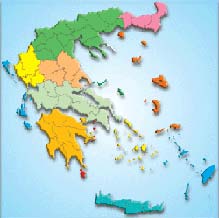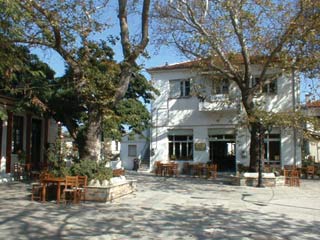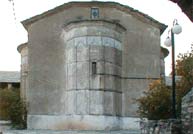
Please click on the map,
the region you want to visit |
|
|
|
|
| |
|
 |
Argalasti, Monastery of Pau |
|
In accordance with old evidence, the village was established by pastoral groups during the Turkish occupation and quickly grew up to such an extent that for a long period of those leap years, was the capital of the villages of Pelion, where the Turk stockman and of the same-faith deacon had their base.
 |
The central square of Argalasti
with the town hall |
|
It is a rich village, which extends up to the southern areas of Magnisian peninsula. It includes a number of settlements with rural cultivations (olives, figs, grapes), livestock, fisheries, while in the last two centuries of the Ottoman rule, it developed the craft of silk.
Strong was also the presence of Argalasti during the Greek Revolution of 1821 in which the people of Argalasti, led by Margaritis Dimadis, took an active part. After the liberation of Thessaly, the Argalasti became the base of the municipality of Spalathron, which included the settlements of Metochi, Bestinika (Xinovrysi), Bir (Kalithea), and also the ports in the Gulf of Pagasitikos, Chorto, Kalamos and Lefokastro.
In 1914, after the dissolution of these first municipalities, Argalasti was one of the largest communities of Pelion until 1999, when, with the implementation of the plan of Kapodistrias, it became again the seat of the municipality of Argalasti.
Today, the visitor is impressed by some neoclassical mansions and by the beautiful and cool square, which is located near the Church of the Holy Apostles Peter and Paul, a basilica aisled church of 1886, built by craftsmen from Zoupa.
Of special interest is also the building of the Girl's School (a donation of Georgatzis C.), which was recently renovated at the early of the 20th century and its director was the scholar and poet Kostas Varnalis.
|
|
|
| |
The most impressive of the
attractions is the marble
neoclassical steeple of the
church, built in 1913.
The building has a square
base with a side length of
10 m., height of 25m., two
Russian bells and a Swiss
clock and it was built as an
imitation of the bell tower of
the Saint Fotini in Smyrni.
|
|
|
| Monastery of Pau |
Leaving Argalasti and going to Kalamos, we arrive at the old monastery of St. Nicholas, which was built in the 15th century and destroyed by the Turks in 1843. Excellent post-Byzantine frescoes decorate the narthex.
In this green area, with lots of water and the inexhaustible source, one can admire the magnificent views over the gulf of Pagasitic.
Continuing the way to the sea, we reach the picturesque beach of Mikri Pau. |
 |
| |
| Stone arched bridges |
The unique architecture of the craftsmen of Epirus and the technical treatment of the stone are reflected in the stone arched bridges of Pelion.
It is impressive how each bridge is included in the natural environment and is an integral part of it.
See the bridges:
in Katsilochori (it is located within Argalasti, at the entrance of the village)
in Rema of Rodia (you will come across it in the route of Argalasti - Lefokastro)
in Lefokastro (it is located within the settlement of Lefokastro)
in Karidi (the bridge is located in the route of Argalasti - Xinovrysi)
and in Ammourtsia (the bridge is located in the route of Argalasti - Kalamos). |
|
 |
Accommodation proposals, entertainment and shopping in Argalasti |
|
|
|